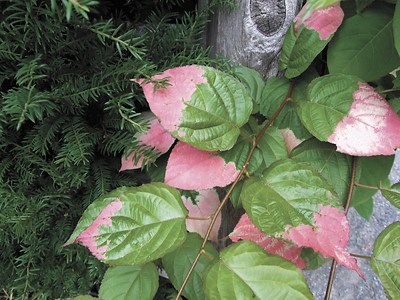My partner John and his cousin Matt built me a garden box this summer that runs the length of our carport.
The idea was that, once planted, we would enjoy privacy from our neighbours and more green to enjoy year round.
We knew that most of the box would be dedicated to emerald cedars. On the other end, I knew I wanted vines to race up the posts and cover the carport, which is a look I knew we could achieve fairly quickly, depending on the vine.
In my mind, a grape vine would do the trick quite nicely. But when I arrived at Southview Greenhouse, Jenny sold me on the kiwi vines zoned for our area.
A hardy vine, the kiwi promised fast growth and a solid yield of fruit.
Plus, Matt hailed from Sydney, so I felt it was a delicious way to honour his hard work.
The variety I picked up was the Arctic Beauty — a lovely variegated leaf that changes as the season progresses: in the spring, an iridescent green leaf will unfurl and smallish white flowers will bloom.
As the leaves grow and the flowers fade, the leaves will develop white blotches, as though sprayed with white paint — the look is so dramatic that you may wonder if it isn’t artificial.
Towards the end of the summer, pink tips may develop, resulting in a trifecta of colour that stuns the passers-by with its good looks.
The species is dioecious, requiring a male to produce fruit. Failing this, you won’t get any. Though most gardeners care little for the fruit, growing the vine for the unusual colour variegations, I believe the fruit is an extra bonus that, with little effort, will be a nice treat.
The fruit tends to be smaller and lacking in fuzz, but bears similar taste to the grocery store variety.
Kiwis are also known for their twining. Given a solid post or arbour, the vine will grow prolifically up to heights of 15 to 20 feet at maturity.
Because the mature plant can become quite heavy because of its wooden trunk, you are best to think ahead and provide it with something with strength and sustainability, lest you have to cut it back in a couple of years to provide it with a new stake to climb.
To prune your kiwi, you should find the strongest looking shoot come spring and treat it as though it were sacrosanct. All else can be pruned back, since the goal here is to encourage a single line to rule — sort of like a Shakespearean tragedy, but without the soul-destroying guilt.
I’ve read that cats like to munch the leaves, but this hasn’t been a problem for me, since the box is high enough that Min-Min — or ol’ fat and lazy — prefers an easier target, namely my Japanese Blood Grass, which he then proceeds to vomit all over the deck.
Since it’s the first year with our vine, I wasn’t betting on any fruit. But I’m watching its vigorous growth with a savage eye. I’ve already marked the leader for glory. Come deep fall, I’ll be ridding the vine of competing lines: “To be or not to be? That is the question!”
Anne Boulton is an avid gardener who lives in Sudbury. Visit her blog at greenboots.ca or contact her at [email protected].
Join Sudbury.com+
- Messages
- Post a Listing
- Your Listings
- Your Profile
- Your Subscriptions
- Your Likes
- Your Business
- Support Local News
- Payment History
Sudbury.com+ members
Already a +member?
Not a +member?
Sign up for a Sudbury.com+ account for instant access to upcoming contests, local offers, auctions and so much more.
